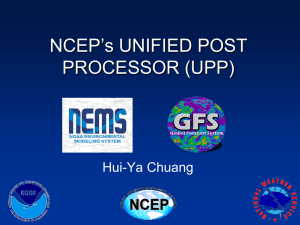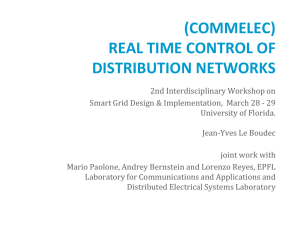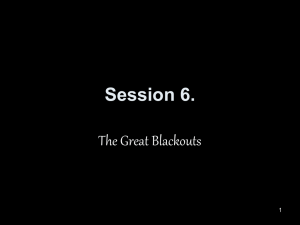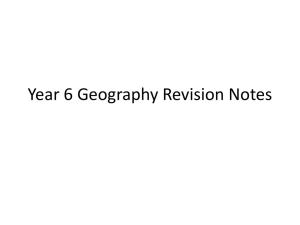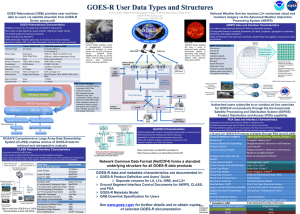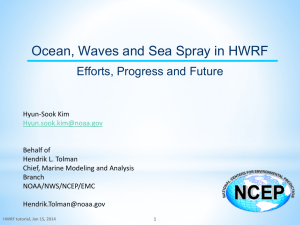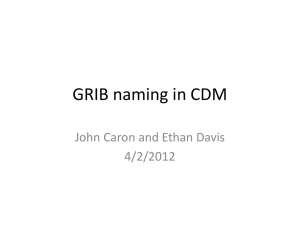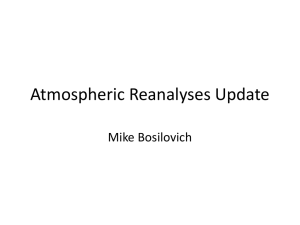Document
advertisement
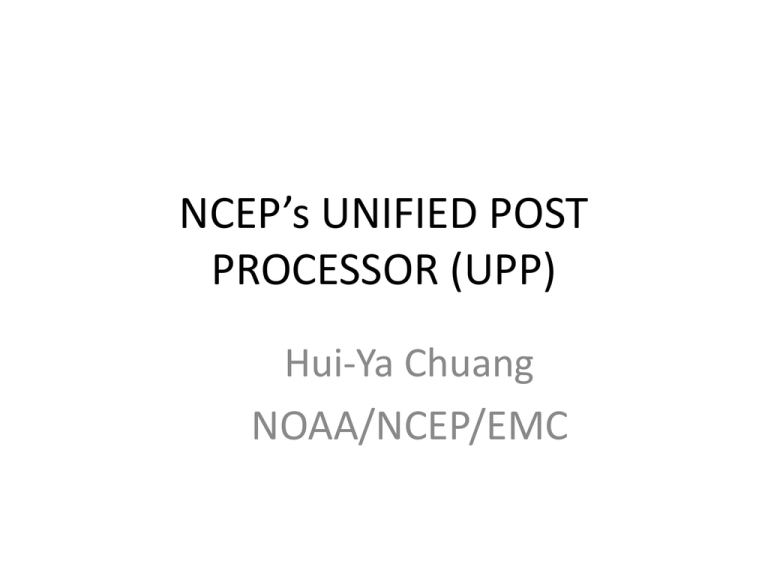
NCEP’s UNIFIED POST PROCESSOR (UPP) Hui-Ya Chuang NOAA/NCEP/EMC Outline • Overview • Components and Functions • Sample fields generated • Running unipost – Controlling output generation • Running copygb – Specifying target grid – Combining parent and nest domains • Visualization The critical big picture overview • Processes model output from both the NMM and the ARW dynamic cores • The UPP generates output in GRIB • The UPP enables product generation on any output grid Components of Post-Processing Note: Bold arrows indicate Operational HWRF path Post control file wrfout Files unipost (primarily ARW) tracker copygb Visualization (general forecast applications) Functions and features of unipost • Performs vertical interpolation onto isobaric and other non-model surfaces • Computes diagnostic fields • De-staggers wind onto mass points for ARW core only • A MPI parallel code that will run faster with more processors Functions of copygb • Perform horizontal interpolation onto a defined output grid • Useful for both cores in creating an output grid not fixed by the model integration domain • Combines the nest data onto the parent domain • Performs de-staggering for NMM core only – Many visualization packages cannot properly handle staggered grids Ingesting WRF model output • unipost reads in WRF model output in netCDF format using the WRF I/O package – A single time per wrfout file works best with sample UPP run scripts (frames_per_outfile=1 in WRF namelist) • By default, the WRF model will provide all fields that unipost requires – Only a concern if you are modifying the Registry file • All model fields read in by unipost for both dynamic cores can be found in the respective User Guides (listed by WRF Registry file variable names) Fields generated by the UPP • The UPP currently outputs hundreds of possible fields – Complete list in the Post Processing Utilities chapter of the ARW or NMM User Guides http://www.dtcenter.org/wrf-nmm/users/docs/user_guide/V3/users_guide_nmm_chap1-7.pdf • Sample fields generated by UPP – T, Z humidity, wind, cloud water, cloud ice, rain, and snow on isobaric levels – Shelter level T, humidity, and wind fields – SLP (two types) Fields generated by the UPP – Precipitation-related fields: accumulated and instantaneous precipitation for total, convective, and grid scale – PBL-related fields – Diagnostic fields: satellite look alike, isentropic, vorticity, and simulated radar reflectivity – Radiative fluxes – Cloud-related fields – Aviation products Derivation of sea level pressure • Standard NCEP SLP: – Based on underground temperatures extrapolated using a constant lapse rate, but subject to the Shuell correction. – Can be very noisy over mountainous terrain in higher-resolution model runs • Membrane NCEP SLP: – Underground temperatures recomputed by relaxing 2Tv using 0. using successive overrelaxation. – Hydrostatic integration of this smooth underground temperature field yields a much smoother SLP field. Computation of Satellite Look Alike Products • They are derived by calling Community Radiative Transfer Model (CRTM) forward model using model predicted cloud, moisture, and surface fields as input • Allow users to make direct comparisons between satellite observations and model forecast • HWRF has been generating simulated GOES operationally for several years and recently F-17 SSMIS • EMC has also been generating NADIR simulated GOES products operationally for both GFS and NAM since 2007 Fields required by the tracker • Input for the tracker program – Primary • MSLP • Relative vorticity* at 10m, 850 and 700 hPa • Geopotential height at 850 and 700 hPa – Secondary • Winds (u/v) at 10m, 850 and 700 hPa – also used to extract intensity *UPP outputs absolute and the tracker derives relative Running unipost and copygb UPP directory contents (subset) • sorc/: • scripts/: source codes sample scripts for running UPP and generating graphics • lib/: libraries used in the build • parm/: control file used when running unipost to specify which variables to output • exec/: UPP executables • configure: script to configure how to compile post • compile: script to compile the UPP code • clean: script to clean created files and executables Input to run unipost • Post needs three input files in addition to model output 1. itag: specifies details on model output to process • model output file name • format of model output (binary or netcdf) • forecast validation time • model name (NMM or NCAR) 2. wrf_cntrl.parm, hwrf_cntrl.nosat, or hwrf_cntrl.sat : control file to let users specify which fields/levels to output 3. eta_micro_lookup.dat: binary look-up table for Ferrier MP • In the scripts provided in with tutorial, these files are automatically generated or linked • Users specify which fields and which level(s) of fields to output by modifying control file GRIB packing precision** (PRESS ON MDL SFCS ) SCAL=(6.0) L=(11000 00000 00000 00000 00000 00000 00000… (HEIGHT ON MDL SFCS ) SCAL=(6.0) L=(11000 00000 00000 00000 00000 00000 00000… Each column represents a single model/isobaric level: “1” = output, “0” = no output Product description – unipost code keys on these character strings. ** larger values more precision, but larger GRIB files. • The wrf_cntrl.parm file has entries for every possible output field • The hwrf_cntrl.nosat file has entries required by the tracker plus some additional diagnostics • The Table 3 in previously mentioned users’ guide explains the character string abbreviations used in the control file: http://www.dtcenter.org/wrf-nmm/users/docs/user_guide/V3/users_guide_nmm_chap1-7.pdf Outputting fields on different vertical coordinates • unipost outputs on several vertical coordinates: – Native model levels – 47 isobaric levels – 7 flight levels above MSL: 914, 1524, 1829, 2134, 2743, 3658, and 6000 m – 6 PBL layers: each averaged over 30 hPa AGL layer – 2 AGL levels: 1000 & 4000 m (radar reflectivity). • Except for AGL and isobaric levels, vertical levels are counted from the ground surface up in the parameter control file Examples of using Post control file • Output T every 50 hPa from 50 hPa to 1000 hPa: (TEMP ON PRESS SFCS ) SCAL=( 4.0) L=(00000 01001 2 5 7 10 20 30 50 70 75 100 01…) 125 150 Isobaric levels increase from left to right: 2, 5, 7, 10, 20, 30, 50, 70, then every 25 hPa from 75-1000 hPa. • Output instantaneous surface sensible heat flux: (INST SFC SENHEAT FX ) SCAL=( 4.0) L=(10000 00000 00000 00000 00000 00000 00000 00000 19 copygb target grid definition • The generic command to run copygb and horizontally interpolate onto a new grid is: copygb.exe –xg”$grid ” in.grb out.grb • Three options on how to specify the target $grid include: – Pre-defined NCEP standard grid number – Defined grid definition • Operational HWRF grid definition • User-defined grid definition – Grid navigation file created by unipost Run copygb – Option 1 • Interpolate to a pre-defined NCEP standard grid (restrictive but simple) – For example, to interpolate onto NCEP grid 212: copygb.exe –xg212 in.grb out.grb • Description of NCEP grids are available online: http://www.nco.ncep.noaa.gov/pmb/docs/on388/tableb.html Run copygb – Option 2a • Create a user-defined Lambert Conformal grid by specifying a full set of grid parameters (complicated but flexible). indicates userdefined grid map type # of points (3=LC) SW corner (millidegrees) Proj cent lon (millidegrees) copygb.exe –xg”255 3 NX NY STARTLAT STARTLON 8 CENLON DX DY 0 64 TRUELAT1 TRUELAT2 ” in.grb out.grb horizontal spacing (meters) Proj true latitudes (millidegrees) copygb –xg”255 3 185 129 12190 -133459 8 -95000 40635 40635 0 64 25000 25000” in.grb out.grb Run copygb – Option 2b • Create a user-defined Polar Stereographic grid by specifying a full set of grid parameters (complicated but flexible). map type (5=STR) copygb.exe –xg”255 5 NX NY STARTLAT STARTLON 8 CENLON DX DY 0 64” in.grb out.grb Center flag (0=NH ; 1=SH) copygb –xg”255 5 580 548 10000 -128000 15000 15000 0 64” in.grb out.grb 8 -105000 Run copygb – Option 2c • Create a user-defined Latitude-Longitude grid by specifying a full set of grid parameters (complicated but flexible). map type (0=LTLN) copygb.exe –xg”255 0 NX NY STARTLAT STARTLON 136 ENDLAT ENDLON DLAT DLON 64” in.grb out.grb NE lat grid spacing NE lon (millidegrees) (millidegrees) (millidegrees) Example of create an operational HWRF output domain: copygb –xg”255 0 1101 901 66700 334800 136 -23300 224800 100 100 0” in.grb out.grb Run copygb – Option 3 • Read in grid navigation file created by unipost (simple, restrictive) – Running unipost produces up to two ASCII files containing grid navigation information which is similar in domain and grid spacing to the model integration domain • copygb_gridnav.txt for a Lambert Conformal grid (NMM only) • copygb_hwrf.txt for a regular Lat-Lon grid (ARW and NMM) – For example: read nav < ‘copygb_hwrf.txt’ copygb.exe –xg “$nav “ in.grb out.grb Note: This file is not used in operations • Put nest data onto the parent domain and generates a new GRIB file with the combined data copygb.exe –g”$grid ” -xM parent_in.grb nest_in.grb GRIB file visualization with GrADS • GrADS has utilities to read GRIB files on any non-staggered grids and generate GrADS “control” files. The utilities grib2ctl and gribmap are available via: http://www.cpc.ncep.noaa.gov/products/wesley/grib2ctl.html • Package download and user guide for GrADS are available online: http://grads.iges.org/grads/gadoc/ • A sample script named run_grads is included in hwrf_utilities/scripts/ that can be used to plot various fields using GrADS Forecast plotted with GrADs: HWRF Simulated SSMIS for Hurricane Melissa GRIB file visualization with GEMPAK • The GEMPAK utility “nagrib” reads GRIB files from any nonstaggered grid and generates GEMPAK-binary files that are readable by GEMPAK plotting programs • GEMPAK can plot horizontal maps, vertical cross-sections, meteograms, and sounding profiles. • Package download and user guide are available online: http://my.unidata.ucar.edu/content/software/gempak/index.html • Further details on this script and using GEMPAK are available in the user’s guide Future Plans • NCEP/EMC and the DTC are working on merging their post codes by late Spring 2014 • Continue to add new products and expand code portability; Add geostationary infrared imagers to get better coverage of the Indian Ocean, East Atlantic and West Pacific near Southeast Asia • Transition all operational model to output Grib2. The benefits include better representation of find resolution grid and up to 50% saving in memory. Additional Resources • WRF-NMM Users Page http://www.dtcenter.org/wrf-nmm/users/ • WRF-NMM Users Guide http://www.dtcenter.org/wrf-nmm/users/docs/users_guide/V3/users_guide_nmm_chap1-7.pdf • WRF-ARW Users Page http://www.mmm.ucar.edu/wrf/users/ • WRF-ARW Users Guide http://www.mmm.ucar.edu/wrf/users/docs/user_guide_V3/contents.html • HWRF Users Page http://www.dtcenter.org/HurrWRF/users/docs/index.php • Questions regarding UPP can be directed to: wrfhelp@ucar.edu Questions?
